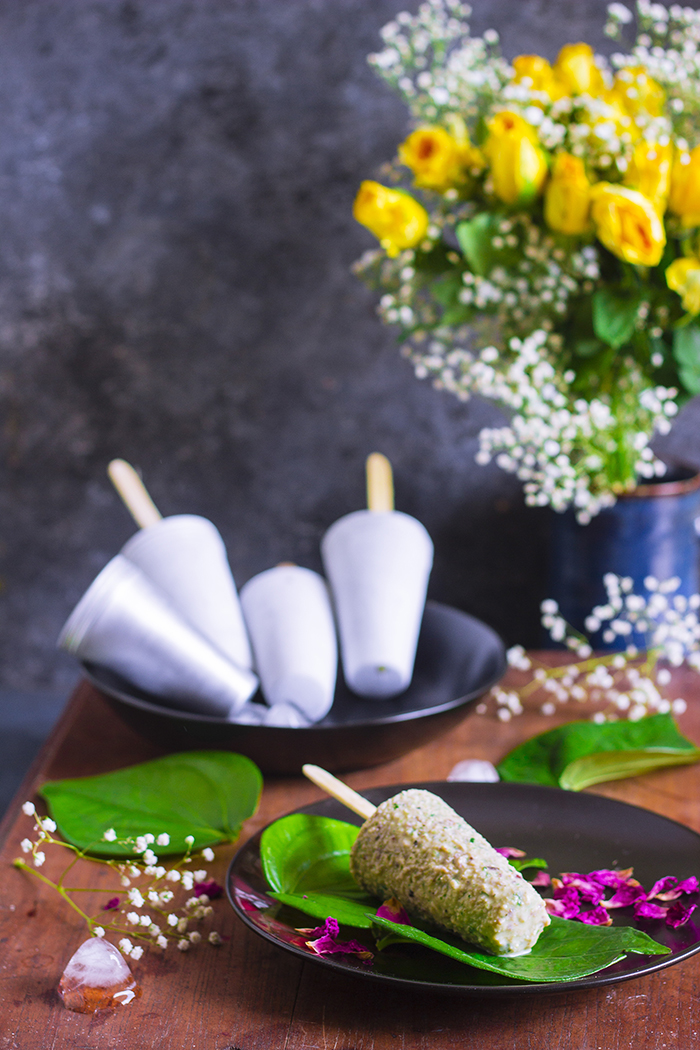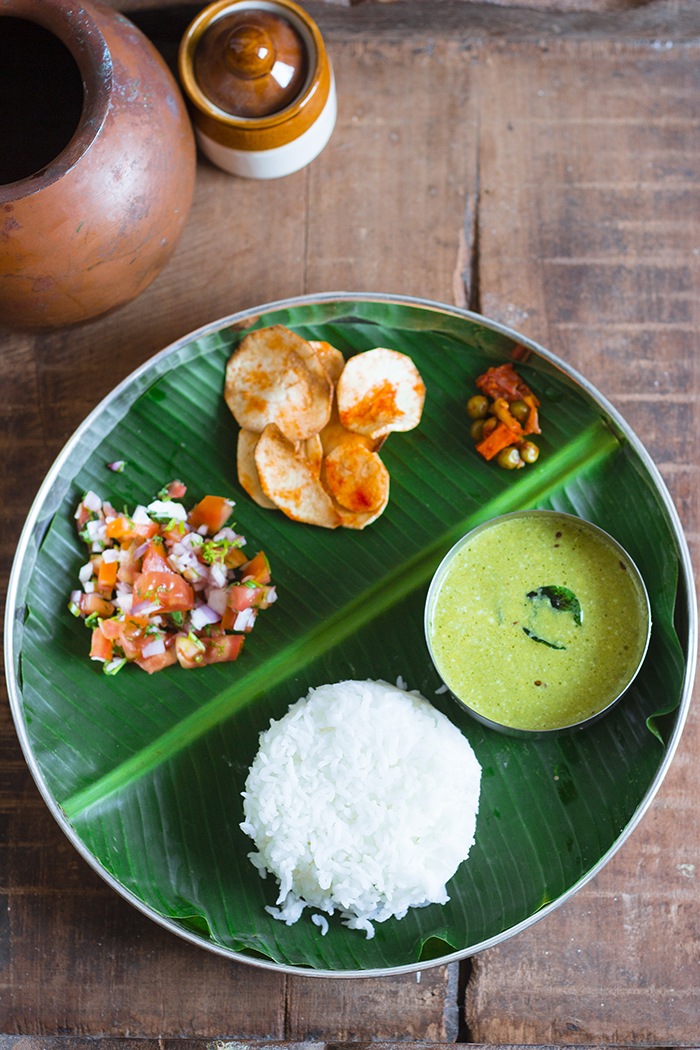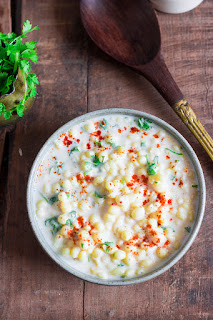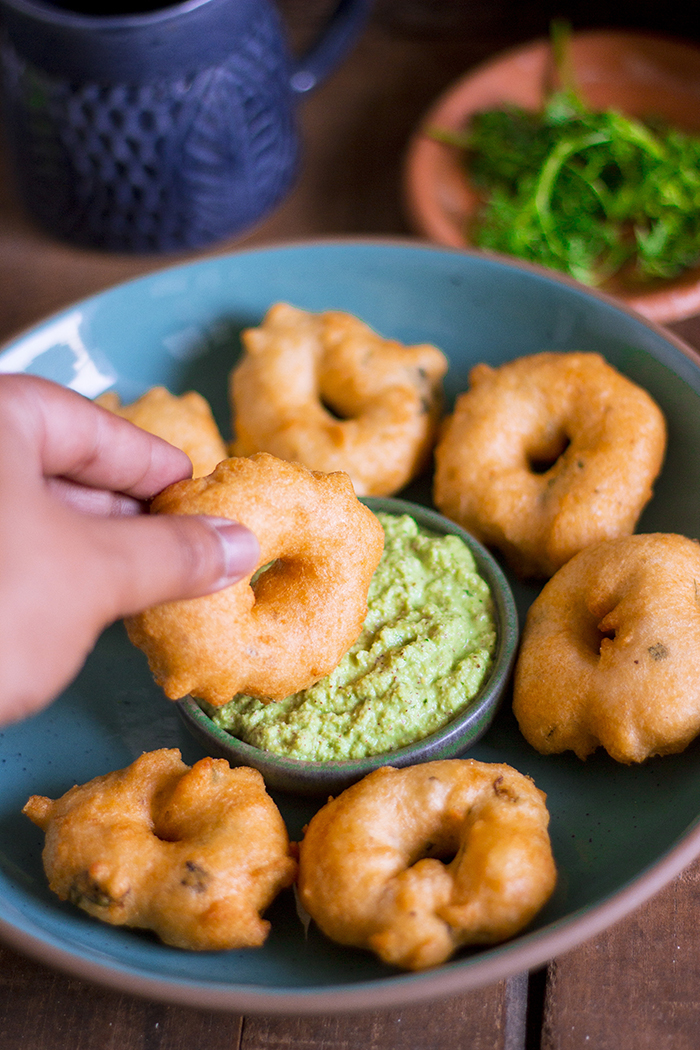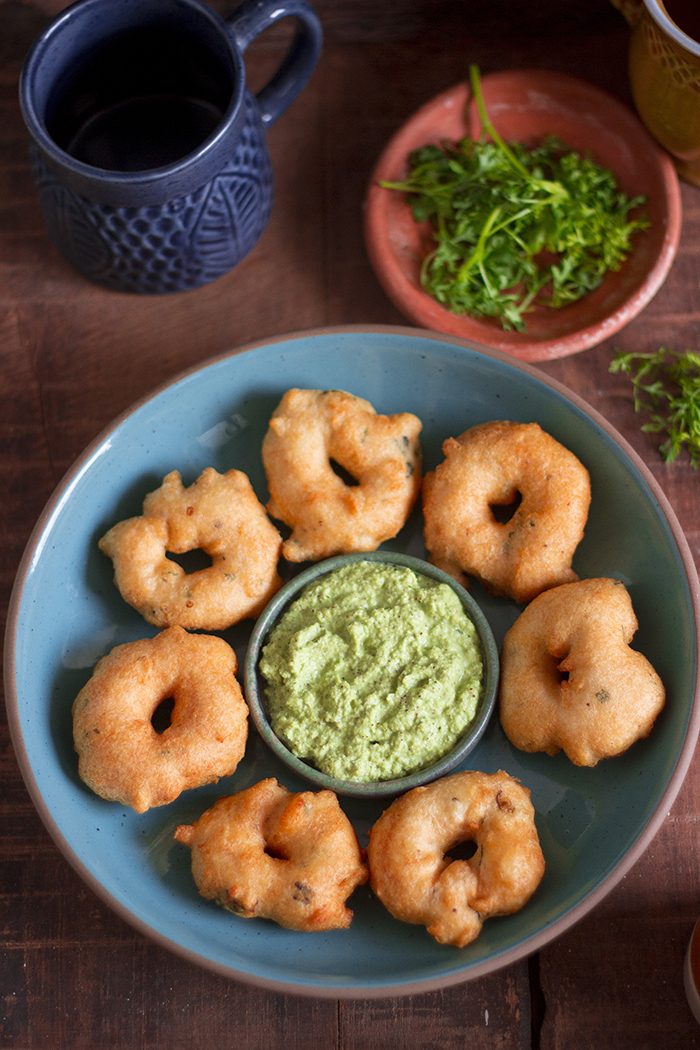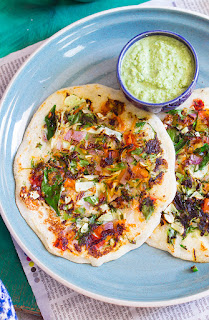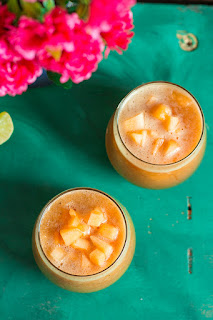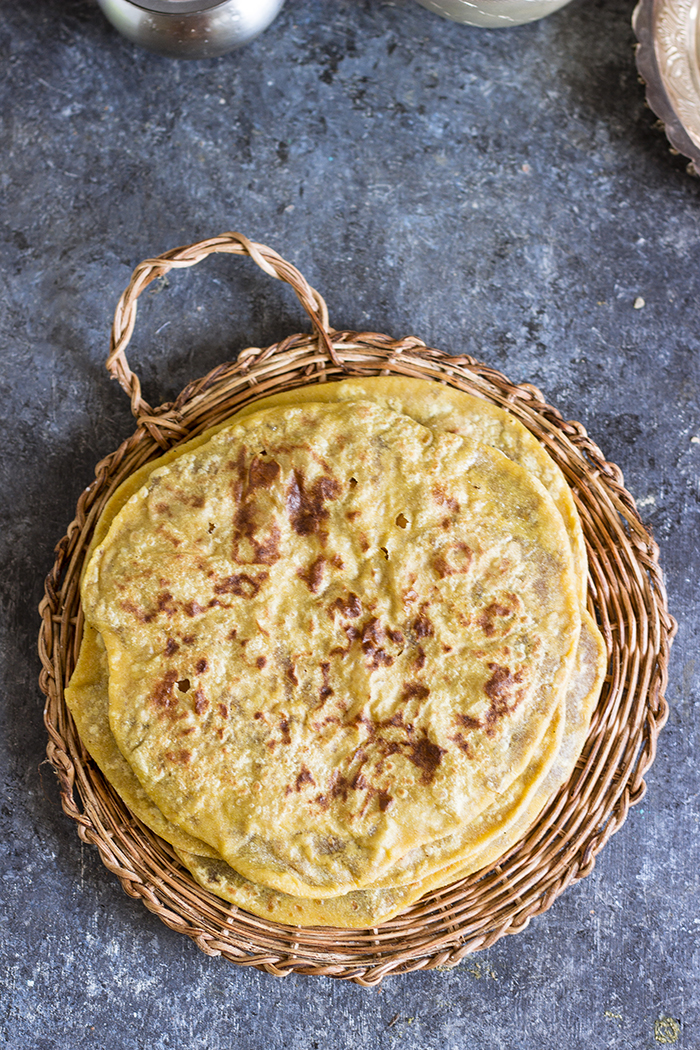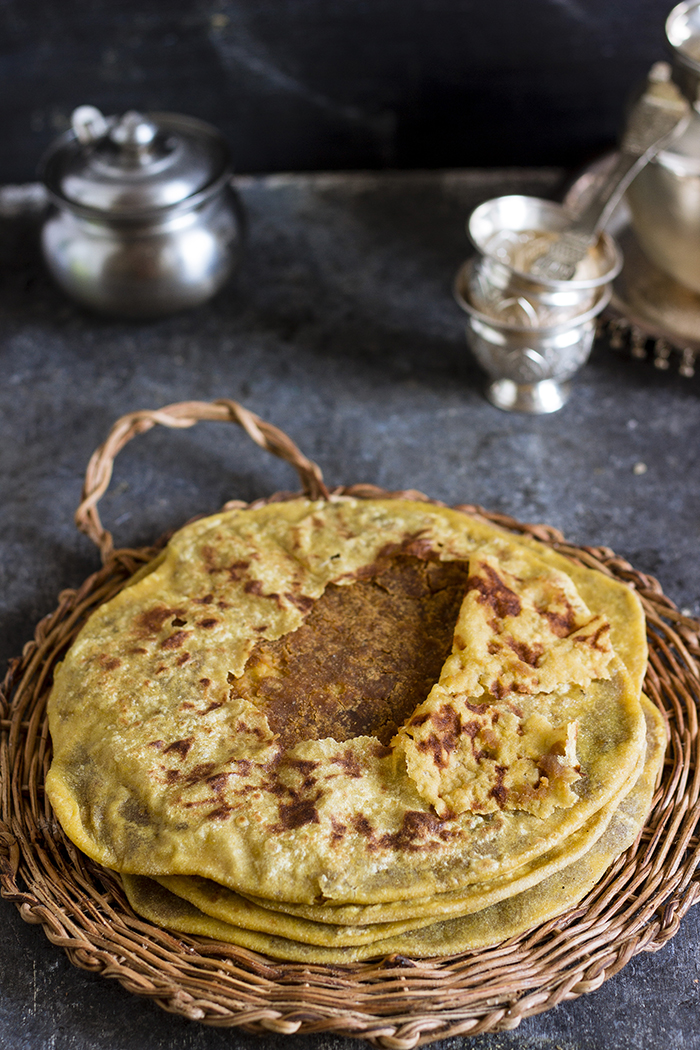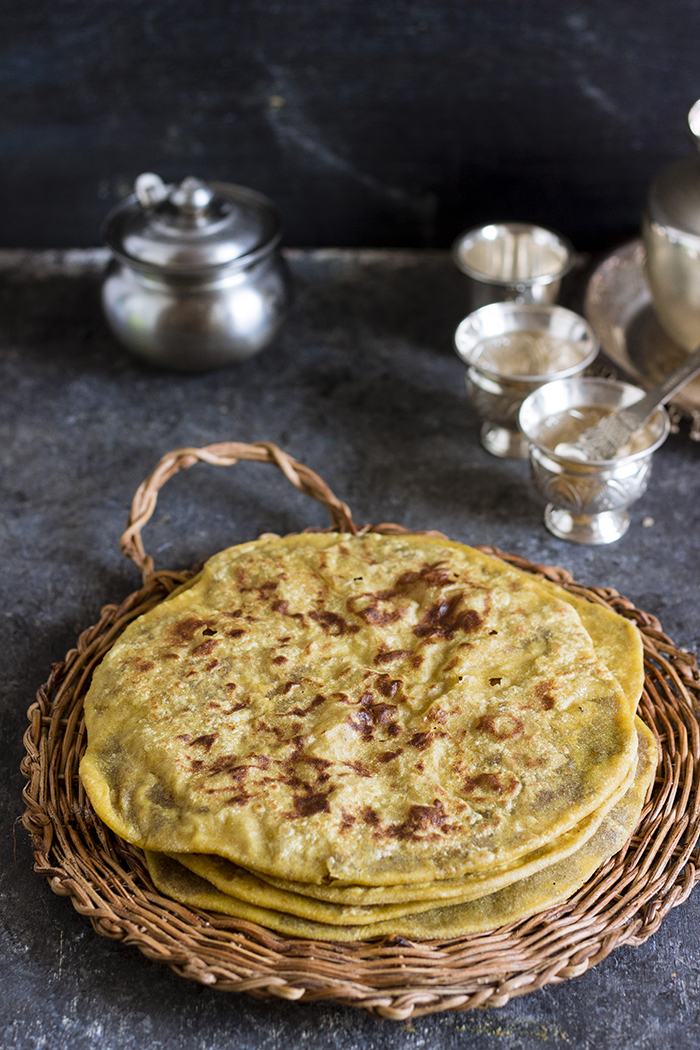Paan Kulfi is a frozen milk based dessert that is flavored with gulkand (rose jam) and paan (betel leaves). This kulfi is of Meetha Paan flavor. Kulfi is a traditional Indian ice-cream made from sweetened reduced milk.
In a hurry? Jump to Video or Jump to Recipe
Kulfi is India's contribution to the world of Ice Cream. Kulfi is denser and creamier than the commonly available ice cream. A Kulfi is made by slowly reducing the milk until it is thick, creamy and caramelized. The reduced milk, is also called Rabdi or Basundi. As the milk caramelizes, it also brings out the natural sweetness of the milk, hence, you don't need much sugar to flavor the milk. The dessert is also amazingly delicious at this stage and I could have bowls of it if there was enough. Flavoring is then, added and then this creamy deliciousness is frozen until it is completely set.
The flavoring for my kulfi was Meetha Paan (sweet betel leaf). This is the favorite flavor in the city right now. If your restaurant is a hip and happening place, you are definitely serving something Paan flavored. I've seen Paan Kulfi, instant Paan Ice Cream made using liquid nitrogen and Paan shots.
A traditional Paan is a betel leaf smeared with limestone and then stuffed with tobacco and betel nuts. This is consumed as a digestive after a heavy meal in several parts of India and South East Asia. As this is detrimental to one's health, the meetha Paan or Sweet Paan was born. The sweet paan is made by stuffing the betel leaf with pieces of dates, fennel seeds, dry coconut (sometimes) and a sweet rose jam called gulkand. This is super delicious. While I say this, I've realized this can be an acquired taste for few.
To make this Paan Kulfi, I used fresh betel leaves that I pureed and added. The betel leaf has a strong pungent taste if consumed by itself but when mixed in the dessert the flavor becomes really mild. I started off with puree of 5 leaves and then went on to add the puree of 7 more leaves, 12 in total to get a prominent taste of paan. Also, instead of gulkand, I added a Kolkata Meetha Paan Mukhwas. This is easily available online as well as in fairs and Malls in bigger cities. If you don't have access to either of these, but have access to a ready made meetha paan from the corner shop, just grind them fine and use them.
Paan Kulfi available in restaurants has a distinct green color. This is achieved by adding a few drops of food coloring. I'm not in favour of food coloring, so I left the kulfi to its natural color.
To make the Kulfi, always use milk with a high fat content. Some folks add cornflour, milk powder or khova to hasten the thickening of the milk. I have used the traditional method of slow cooking instead. While this takes a little more time, the kulfi ends up tasting very good. You can literally keep the milk on the lowest heat possible and continue to do your work, just peeking in every once in a while to ensure it is overflowing or burning and to scrape the sides. To cook the kulfi sooner, you can also divide the milk into 2 or more pots and reduce them individually before mixing them all together and adding sugar.
I hope you love this Paan Kulfi as much as my family and I. Wishing you a very happy Summer!
If you made this recipe, let me know! Leave a comment here or on Facebook, tag your tweet with @oneteaspoonlife on Twitter and don't forget to tag your photo @oneteaspoonoflife on Instagram. You can also email me at onetspoflife@gmail.com I'd love to see what you are upto.
If you like this recipe, do not forget to share it with your friends and family!
Video Recipe
--------------------------------------------------------------------------------------------------------------------------
Paan Kulfi Recipe | How to make Meetha Paan Kulfi
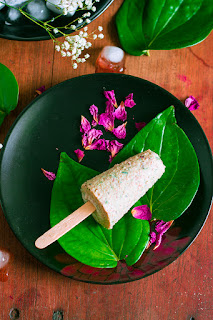 Paan Kulfi is a frozen milk based dessert that is flavored with gulkand (rose jam) and paan (betel leaves). This kulfi is of Meetha Paan flavor. Kulfi is a traditional Indian ice-cream made from sweetened reduced milk.
Paan Kulfi is a frozen milk based dessert that is flavored with gulkand (rose jam) and paan (betel leaves). This kulfi is of Meetha Paan flavor. Kulfi is a traditional Indian ice-cream made from sweetened reduced milk.Recipe Type: Dessert
Cuisine: Indian
Prep Time: 9 Hours
Cook time: 2 Hours
Total time: 11 Hours
Yield: Makes 8 Kulfis
Ingredients:
2 litres Full Fat Milk
0.5 cup Sugar
10-12 Betel Leaves
2-3 Tbsp Meetha Paan Mukhwas or Gulkand
1 Tbsp Almonds, chopped
1 Tbsp Cashewnuts, chopped
1 Tbsp Pistachios, chopped
Method:
1. Boil the 2 litres of milk until it comes to a rolling boil.
2. Reduce the heat to low and continue to boil.
3. Keep stirring to prevent the milk from burning.
4. Keep scraping the solidified milk from the sides of the pot and add it to the boiling milk.
5. Once the milk has reduced to half, add the sugar. Half a cup of sugar makes the kulfis pretty sweet. Add by the spoonfuls to get the right amount of sweetness.
6. Once the milk has reduced to 1/3rd the quantity and has become thick and creamy, remove from heat and allow to cool down to room temperature.
7. Puree the betel leaves (paan) with a little milk until smooth. Use 4-6 paans for a milder taste and 10-12 paans for a stronger taste.
8. After the milk has cooled, add in the chopped nuts, meetha paan mukhwas or gulkand and the paan puree. Mix well.
9. Fill into the kulfi moulds and freeze for around 2-3 hours.
10. The kulfis should be 50% set in 2-3 hours. Remove from the freezer and gently place the ice-cream stick. This step can be skipped if you are not planning to add the ice-cream stick.
11. Place the moulds back in the freezer and freeze for 8-10 hours or until completely set.
12. To demould the kulfi while serving, dip the kulfi mould in warm water, the kulfi should loosen. If using an ice-cream stick, twist the kulfi and pull it out gently. If not then place the mould on a plate and tap the mould until the kulfi comes out.
13. Serve immediately.
If you liked this, you may also like:

